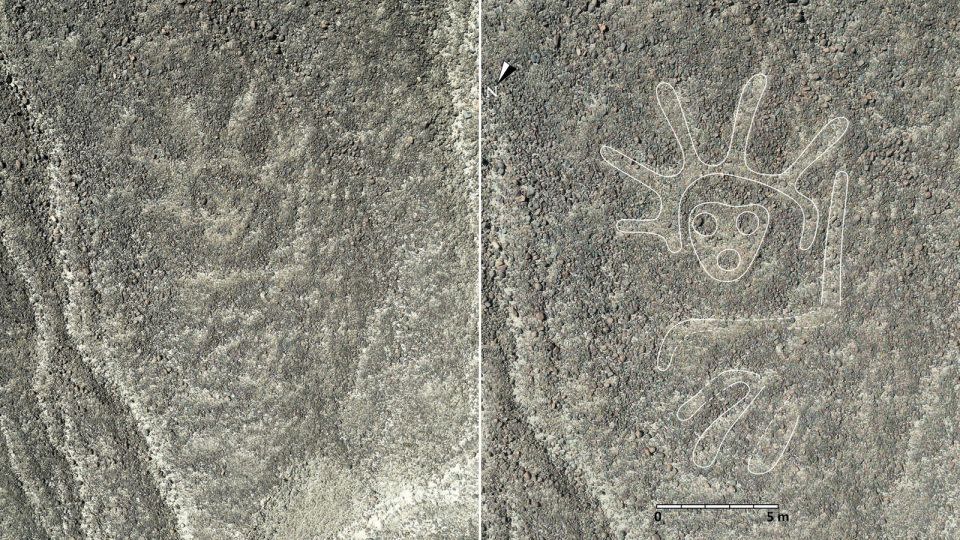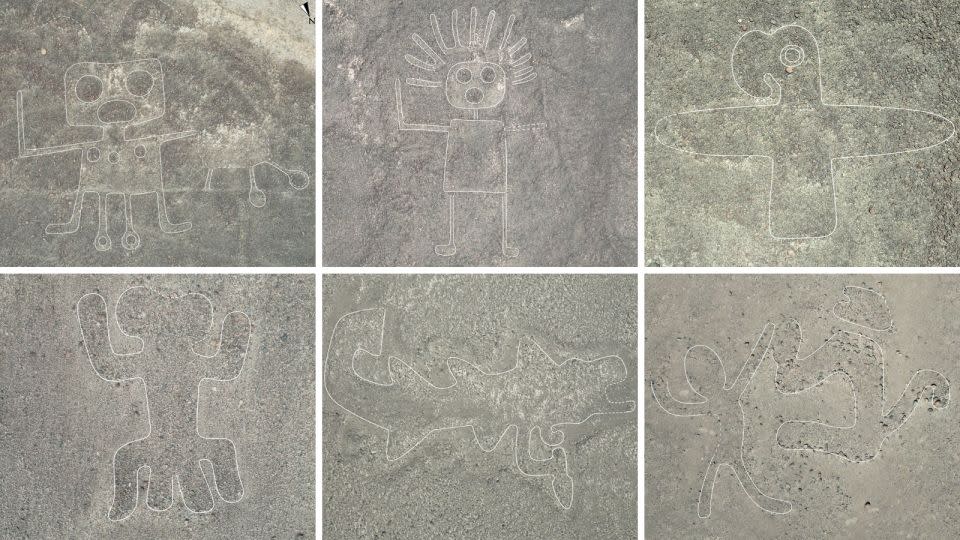Sign up for CNN’s Wonder Theory science newsletter. Explore the universe with news about fascinating discoveries, scientific developments and more.
Archaeologists working in Peru, assisted by artificial intelligence, have discovered 303 previously unknown giant symbols carved into the Nazca Desert.
The carvings include birds, plants, spiders, humanoid figures with headdresses, decapitated heads and a killer whale wielding a knife.
Described in a study published Monday in the journal PNAS, the discovery nearly doubles the number of known Nazca geoglyphs, mysterious works of art formed in the ground by moving rocks or gravel that are some 2,000 years old. The researchers’ findings also shed some light on the enigmatic purpose of the symbols.
Located 50 kilometers inland from Peru’s southern coast, the enormous symbols were found in the desert from the early 20th century. About 500 meters above sea level, the geoglyphs have survived the centuries because the dry desert area is sparsely populated, not affected by floods and unsuitable for growing crops.

The number of new finds has increased in recent years due to the use of high-resolution remote imaging, with an average of 19 geoglyphs found per year between 2000 and 2020, according to the study. However, the use of AI to select potential candidates has since accelerated the pace and, more broadly, promises “a revolution in archaeological discovery,” the study said.
A group of researchers led by Masato Sakai, professor of archeology at Japan’s Yamagata University, has made the latest geoglyph discovery by training an AI object detection model with high-resolution images of the 430 Nazca symbols mapped in 2020. The team included researchers from IBM’s Thomas J. Watson Research Center in Yorktown Heights, New York.
Their biggest challenge was the limited number of images. According to the research, such models are typically trained using tens of thousands of images.
Narrowing the Nazca field
The team chose to focus on the smaller and more figurative of the two types of symbols discovered in the desert. Figurative geoglyphs are typically about 30 feet long and are more difficult to identify than the larger line type, which is 300 feet long and thus easier to see during aerial surveys.
The AI model was certainly not perfect. It suggested more than 47,000 potential sites from the desert area, which covers 629 square kilometers (243 sq mi).


The team screened and ranked these suggestions, identifying 1,309 “high potential” candidate sites. For every 36 suggestions from the AI model, the researchers identified ‘one promising candidate’.
Nevertheless, the study authors noted that using AI was a “game changer,” in terms of reducing the amount of labor required to refine the search. It allowed the “focus to shift to valuable, targeted fieldwork on the Nazca Pampa,” the study said.
Between September 2022 and February 2023, the team tested the accuracy of its model in the Nazca Desert, mapping promising sites on foot and using drones, ultimately “ground truthing” 303 figurative geoglyphs.
“The geoglyphs in good condition were immediately recognized for what they were,” Sakai said in an email. “For those that are in poor condition, we investigate what they are through detailed fieldwork.”
Of the 303 newly discovered figurative geoglyphs, 178 were suggested by the model, and 125 were additional finds. Of these, 66 were found as part of an AI-discovered cluster of geoglyphs, while 59 were discovered during fieldwork without any AI assistance.
There may be many more geoglyphs waiting to be discovered.
The team was unable to interview 968 of the promising candidates during the fieldwork season described in the study. Given the initial success rate of fieldwork based on the AI model, the study estimates that at least 248 additional figurative geoglyphs could be discovered.
It is “amazing” to have doubled the number of known geoglyphs, especially given the limited training data, says Amina Jambajantsan, researcher and data scientist at the Department of Archeology at the Max Planck Institute for Geoanthropology in Jena, Germany. Jambajantsan was not involved in the Nazca research, but uses an AI model to identify burial mounds in Mongolia based on satellite images.
Her own work often followed a similar pattern to that of the Nazca team, she said, with AI-based suggestions often leading to additional discoveries on the ground during fieldwork. “AI is great, but people are still needed,” she said.
AI has the potential to make enormous contributions to archaeology, although the models are not yet perfectly accurate, she said.
“The problem is that archaeologists don’t know how to build a machine learning model and data scientists are generally not really interested in archeology because they can get a lot more money elsewhere,” Jambajantsan added.
Deciphering the purpose of the Nazca symbols
It is not clear why the Nazca people made the symbols. The main hypothesis is that they formed a sacred space that may have been a place of pilgrimage. Other theories suggest they played a role in calendars, astronomy, irrigation or for exercise, such as running or dancing, or communication, the study said.
An analysis of the newly discovered symbols, along with those already known, revealed some interesting trends, Sakai said.
The larger line-type geoglyphs that are easily visible from above typically depict wild animals, such as animals or plants, while the smaller relief-type geoglyphs include people or things involving humans, such as human sacrifices or domesticated llamas.
The research also more clearly revealed a network of trails in the desert, many of which were close to different groups of symbols.
The smaller geoglyphs were located along ancient winding paths likely built across the desert by Nazca people who viewed the symbols in small groups, the study said. The larger Nazca symbols were located near networks of straight lines, squares and trapeziums etched into the earth.
These symbols, according to the study, were likely used for ceremonial activities, perhaps at the end of a pilgrimage, and could be considered planned public architecture.
Sakai said work is underway to decipher the precise meaning of the geoglyphs and their mysterious purpose, which the researchers hope to publish in the future.
“Our findings suggest that their meaning is shaped by their combinations,” he said, referring to the way the Nazca geoglyphs are grouped together.
For more CNN news and newsletters, create an account at CNN.com